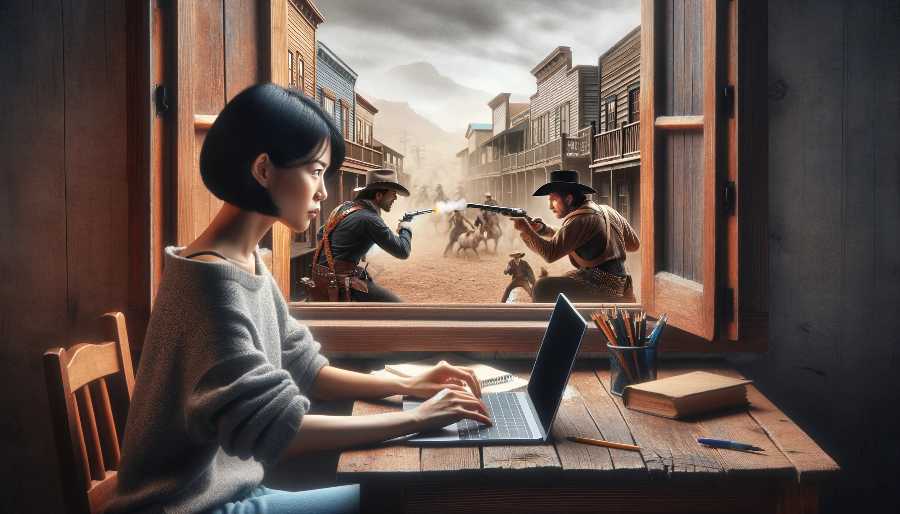Write an Exciting Story Climax
by N. Strauss
Skip to Topic
- What is a story climax?
- Where the climax fits in the plot
- Examples
- Keys to success
- Ways to add excitement
- Two mistakes to avoid
What is a story climax?

The climax is the most exciting scene in a story, the one readers have been waiting for. It's...
- the big battle
- the big game
- the scene where the hero rushes to the church to stop the woman he loves from marrying the wrong man.
In a quieter sort of story, it may be the scene where the character must make a key decision about their identity or values.
The climax normally happens during the last part of a story, soon before the ending.
It's the scene that determines how the story will end.
It's where readers will finally get an answer to the main question posed by the story...
- Will the good wizard defeat the bad wizard and save the world?
- Will the scrappy new baseball team win against the champions?
- Will Susana marry Bachelor #1 or Bachelor #2?
- Will Harriet find a way to come to terms with her past?
Let's talk about some techniques to write an effective story climax, as well as pitfalls to avoid. We'll also look at some examples from literature.
But, first, let's look at how the climax fits into the overall structure of a story...
Story climax and plot structure

Classic plot structure is about a character struggling to solve a problem or reach a goal. This struggle is the story conflict.
The character's struggle gives readers a reason to turn pages. Readers want to know if the character will succeed or fail.
In a novel, the story conflict is often presented as a series of battles that increase in intensity.
The character makes an attempt to solve their problem. When that doesn't work (or even makes the problem worse), the character has to try something more drastic, and so the conflict builds until it reaches a breaking point. This is the climax.
A short story might start right before the story climax: the character's life is about to explode. The short story shows the explosion and its result.
Click here to get our free three-day course on story structure.
Examples of story climaxes

Let's look at some examples of effective story climaxes.
Example: HARRY POTTER AND THE PHILOSOPHER'S STONE by J.K. Rowling
This novel's conflict centers around Harry's efforts to keep the Philosopher's Stone from falling into the wrong hands. The plot starts building toward a climax when Harry learns that someone is about to steal the stone. In the climax, Harry goes to the secret chamber where the stone is hidden and battles with the thief (his teacher Quirrel, who has been possessed by the evil wizard Voldemort).
Rowling uses several classic techniques to create a suspenseful climax:
- raising the stakes: Harry's attempt to stop a theft turns into a life-or-death battle.
- a surprise revelation: The villain is not who Harry had expected.
- a ticking clock: Harry is hurrying to try to get to the stone before it is stolen.
- a confined space: Harry is isolated and trapped with the villain in a hidden chamber, adding to the tension of the scene.
Example: A IS FOR ALIBI by Sue Grafton
This is a detective novel, and its conflict centers on the investigation of a murder. During the investigation, two additional people get murdered.
Many detective novels have a climax where the sleuth confronts the murderer, who reveals their guilt. A is for Alibi has TWO scenes like this...
Grafton's sleuth, Kinsey, confronts the murderer, who confesses. At this point, any mystery reader will assume that they've reached the story climax. But then there's a plot twist. The murderer only admits to one of the three murders that have occurred during the novel. Which means there's a second murderer out there...
This "fake" story climax quickly leads to the real one, where Kinsey finds Murderer #2 and he tries to kill her.
Story climaxes are often more obvious in genre fiction like fantasy novels and mysteries. Literary fiction doesn't always exactly fit the classic model of story structure.
More than a series of escalating battles that build to a do-or-die moment, literary novels often show a series of events that lead to an evolution in the main character. But here are two examples of story climaxes from literary fiction.
Example: BROOKLYN by Colm Toibin
In this novel, a main character named Eilis feels divided between her old life in Ireland and her new life in the U.S.. She returns to Ireland for a visit and starts to pick up her old life there without telling anyone that she's married a man in the U.S. The novel's climax occurs when a woman from Eilis's Irish life finds out about the marriage and confronts Eilis, forcing Eilis to choose.
Example: HOUSEKEEPING by Marilynne Robinson
The main character of this novel is a child named Ruth. Ruth, whose family history has been marked by instability longs for a stable home life. The story conflict centers on her desire for stability. After a series of family deaths, Ruth's Aunt Sylvie comes to take care of Ruth and her younger sister. But Sylvie has a transient lifestyle, and Ruth is afraid she'll leave. A series of crises (e.g., Ruths sister leaves home, Sylvie temporarily disappears, the sheriff threatens to remove Ruth from Sylvie's custody) lead to a climx where Ruth and Sylvie burn down their house and start a transient life together.
As a climax, the burning down of the house is decisive, a point of no return. And it solves the story's conflict (instead of a stable home, Ruth chooses a kind of permanent transience with Sylvie).
Keys to a successful story climax

1) Let the main character's actions determine the result.
The story's about your main character, so they should be at the center of the climax. Let your character's strengths save the day (or let their weaknesses sink the ship).
2) Lay the groundwork,
If the character's going to use a special strength, talisman, magic power, or weapon during the story climax, set that up in advance. That way, when your character pulls a lockpick out of his pocket, readers will think, "Of course! Josh's handy lockpick that I saw him using in Chapters 1 and 2!" instead of, "What? Why does he have a lockpick?"
3) Build up to it.
You can make the climax more exciting by building up to it. Create suspense and anticipation in advance, and set the stakes.
For example, in a love story, you'll build up the romantic tension between the couple before you finally, satisfyingly, bring them together.
In a mystery, you'll build curiosity about the solution before you finally reveal the answer.
In a novel where the climax is a big football game, you'll build up to it by showing how nervous the hero is and how much he has to lose if the game goes badly.
4) Make it count.
Your story climax is the moment readers have been waiting for, so give them their money's worth. Show the scene in vivid detail without leaving out any of the good parts.
Ways to make a story climax more exciting

Here are some techniques you can use to add drama to your story climax. None of these are requirements, just tools for your writer's toolbox.
1) Raise the stakes.
You can add to the suspense during the climax by raising the stakes for the main character—by putting the character in danger, or giving them more to gain or lose.
The detective lures the killer into a trap... but then the killer turns the tables and abducts the detective. Now the stakes are higher—instead of just trying to bring the killer to justice, the detective is fighting for his own life.
2) Add a ticking clock.
Another way to create tension is by adding time pressure. For example, the main character only has three hours to find and defuse the bomb. Or, the main character has to race through the airport to tell someone he loves them—before that person hops on a plane and leaves forever.
3) Add a surprise twist or revelation.
The hero and his best friend go to confront the enemy. But when the enemy attacks the hero, his best friend helps the enemy! The hero suddenly understands that his so-called best friend has been helping the enemy all along!
Or, the hero and his best friend go to confront the enemy. But instead of fighting them, the enemy shows them his police badge. It turns out he's an undercover detective, investigating the same crime they are. All of them are actually on the same side! But then the real enemy arrives...
4) Add a false resolution.
You've probably seen this technique used in horror movies. The hero kills the monster, and it looks like the story is pretty much over. But just when the audience is breathing a sigh of relief, the monster sits up again... Or, its body explodes, and a hundred baby monsters come flying out...
The false resolution gets the audience to relax, so that the new onslaught comes as a shock.
5) Use energetic language.
When the action speeds up, you can use sentence structures that create a sense of things happening rapidly.
You can use short sentences or fragments to create a sense of urgency...
I pulled myself up. Felt my arm. Not broken. Looked around me. The sidewalk was empty. But I heard something in the distance. Police sirens. I had to get out of there.
Or, you can use long sentences that create a blur of activity.
The squirrel bit my leg, and I shook it off, but it came right back at me—I looked around for a weapon, saw the snow shovel, but it was too far away, and now the squirrel was climbing my leg. I kicked it off, thinking of Marjorie, poor Marjorie, who'd told me about demon squirrels and I hadn't believed her—but it was coming at me again, and I lunged across the garage, trying to reach the snow shovel, slipped, and fell to the ground, smashing my bad knee, and the squirrel made a terrifying hissing noise...
Two mistakes to avoid
Here are two mistakes to avoid in your story climax.
1) DON'T race through it too fast.
Readers have been waiting for this moment. Give them a good show!
DON'T write the climax like this:
Ronaldo told her it wasn't true, and Julia burst into tears. They kissed passionately, and everything was fixed. The End.
No! What did Ronald say? What did Julia answer? At what point did the truth finally hit her? Who initiated the kiss, and how, and what led up to it? Was Ronaldo drying her tears, and then his hand slid up into her hair... Did she cling to him? Did he smell like woodsmoke?
The reader wants all the juicy details! They want to see and hear and smell and feel everything.
2) Avoid Deus Ex Machina.
Ideally, the result of your climax should come from your hero's character and actions. But it definitely should not feel random.
Your hero is alone in the middle of the woods with the bandits. There are four of them and only one of your hero. Your hero is weaponless, and he has a sprained ankle, and things are looking pretty bleak for him. The sky is darkening, and thunder rumbles in the distance. And then... four lightning bolts come out of the sky and strike down the four bandits, leaving your hero unharmed.
This is excellent luck for you hero. Not so much for your reader, who is feeling cheated. The reader is rooting for the hero and would love to see him escape... but only if they can believe what they're reading.

Story Climax - Next Steps
For more writing advice and inspiration, be sure to sign up for our free email group. Also check out:
About the author
N. Strauss taught creative and expository writing at the University of Michigan before moving to the Czech Republic and then Spain. She has an M.F.A. in Creative Writing from the University of Michigan and a B.A. in English from Oberlin College. In 2009, she founded Creative Writing Now in collaboration with the author Linda Leopold Strauss, who has taught writing courses for the Institute of Children's Literature and published children's books with Scholastic, Holiday House, Houghton Mifflin, and others.